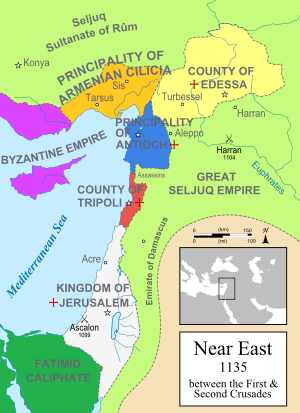Leo I, Prince of Armenia
| Leo I | |
|---|---|
| Lord of Cilicia | |
| House | Roupenians |
| Father | Constantine I |
| Mother | An unnamed great-granddaughter of Bardas Phokas |
Leo I).
He learned to exploit the open, yet restrained, hostilities between the
He expanded his rule over the
Leo was captured after being invited to a meeting by the Byzantine Emperor
His early life
Leo was the younger son of Constantine I, lord of Armenian Cilicia.[citation needed] It is likely that his mother was the great-granddaughter of Bardas Phokas.[citation needed]
When Constantine I died, Leo’s brother
In 1111,
/Leo/ invited many famous warriors to join him, and allured them by great rewards. Forward in battle, he prepared himself, and often fought against the foreigners or infidels, took their forts and put all the inhabitants to the sword. He was the admiration of warriors, and the fear of foreigners or infidels, so that they called him the new Ashtahag.
— Vahram of Edessa: The Rhymed Chronicle of Armenia Minor[5]
His rule

Thoros I died in 1129 (or in 1130), and his son Constantine II died a few months later, in the course of a palace intrigue.[1] Other authors (e.g., Jacob G. Ghazarian, Vahan M. Kurkjian) suggest that Thoros I died without a male heir and was directly succeeded by Leo.[2][3]
Conflicts with the Franks
In February 1130,
Soon after Bohemond II’ death, Leo protected in his rear by an alliance with the Danishmend emir, descended into the plain; after a brief unsuccessful siege of
In 1136, the new prince of Antioch,
In Leo’s absence his three sons quarreled: the eldest,
The (re-)occupation of Cilicia by the Byzantines
In the spring of 1137, the imperial army, with the Emperor and his sons at its head, assembled at
Leo relied on the great fortifications of Anazarbus to hold him up.[1] Its garrison resisted for 37 days, but the siege engines of the Byzantines battered down its walls, and the city was forced to surrender.[1] Leo retreated into the high Taurus Mountains, while the emperor led his forces southward into the plain of Antioch.[1]
After the emperor had asserted his authority over the Principality of Antioch, he returned to Cilicia to finish off its conquest. The family castle of
His last years in exile
Leo and his two sons were sent to prison in Constantinople. They were soon allowed to live in the court under surveillance and John acted more honorably towards Leo, with the two dining and going on hunting parties together. Leo's son Roupen was later murdered by Byzantine grandees that were envious of his strength.[4]
Leo died in Constantinople.[2]
Marriage and children
The name and the origin of his wife are not known with certainty.[citation needed] Orderic Vitalis states that Leo was "uncle to the wife of Bohemond II of Antioch". On this basis, some authors have proposed that his wife was either an unnamed daughter of Count Hugh I of Rethel, or she may have been an unnamed daughter of Gabriel of Melitene.[citation needed]
- (?) unnamed daughter, who was the wife of a “Frankish knight from Antioch”, and mother of the Regent Thomas[citation needed]
- unnamed daughter, the wife of Vasil Dgha[citation needed]
- (?)[citation needed] Constantine[1] (? – Edessa, 1138/1144)[citation needed]
- Thoros II of Cilicia (? – February 6, 1169)[citation needed]
- Stephen (before 1110 – February 7, 1165)[citation needed]
- Mleh I of Cilicia (before 1120 – Sis, May 15, 1175)[citation needed]
- Roupen (after 1120 – Constantinople, 1141)[citation needed]
(Leo’s second marriage proposed by Rüdt-Collenberg is speculative.)[citation needed]
Footnotes
- ^ a b c d e f g h i j k l m n o p q r s t u v w x y z aa ab ac ad Runciman, Steven. A History of the Crusades – Volume II.: The Kingdom of Jerusalem and the Frankish East: 1100–1187.
- ^ a b c d e f g h i j k l m n Ghazarian, Jacob G. The Armenian Kingdom in Cilicia during the Crusades: The Integration of Cilician Armenians with the Latins (1080–1393).
- ^ a b c d e f Vahan M. Kurkjian (2005-04-05). "A History of Armenia". Website. Bill Thayer. Retrieved 2009-07-19.
- ^ a b c Bucossi, Alessandra; Suarez, Alex Rodriguez. John II Komnenos, Emperor of Byzantium: In the Shadow of Father and Son.
- ^ Vahram (2008-09-10). "Chronicle". Text Archive. Internet Archive. Retrieved 2009-07-19.
Sources
- Bucossi, Alessandra; Suarez, Alex Rodriguez: John II Komnenos, Emperor of Byzantium: In the Shadow of Father and Son; Routledge, 2016, Abingdon; ISBN 978-1-4724-6024-0
- Ghazarian, Jacob G: The Armenian Kingdom in Cilicia during the Crusades: The Integration of Cilician Armenians with the Latins (1080–1393); RoutledgeCurzon (Taylor & Francis Group), 2000, Abingdon; ISBN 0-7007-1418-9
- Runciman, Steven (1952). A History of the Crusades, Volume II: The Kingdom of Jerusalem and the Frankish East. Cambridge: Cambridge University Press.
External links
- Smbat Sparapet's Chronicle
- The Barony of Cilician Armenia (Kurkjian's History of Armenia, Ch. 27)
